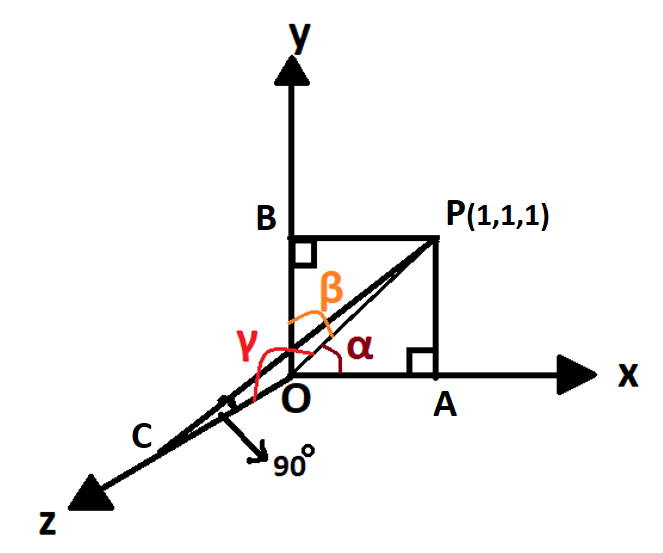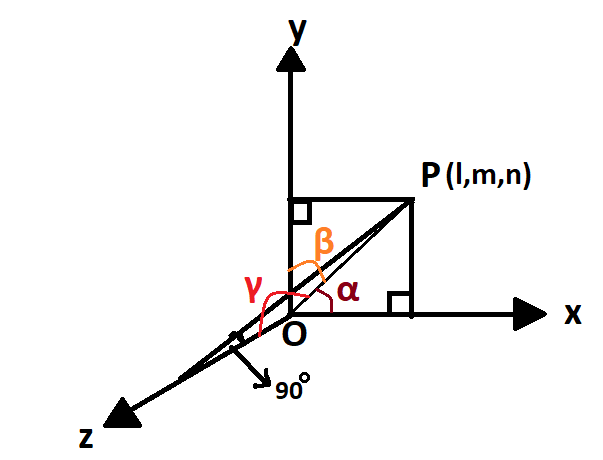
The direction cosines of the line x = y = z are
A. $\dfrac{1}{{\sqrt 3 }},\dfrac{1}{{\sqrt 3 }},\dfrac{1}{{\sqrt 3 }}$
B. $\dfrac{1}{3},\dfrac{1}{3},\dfrac{1}{3}$
C. $1,1,1$
D. None of these
Answer
219.9k+ views
Hint: Pick a point on the line whose equation is x = y = z. Then find $\cos \alpha ,\,\cos \beta ,\,\cos \gamma $ using the right-angled triangles. Then use the fact that the squares of direction cosines add up to 1 to find the third direction ratio.
Formula used: ${\cos ^2}\alpha + {\cos ^2}\beta + {\cos ^2}\gamma = 1$, Distance = \[\sqrt {{{({x_1} - {x_2})}^2} + {{({y_1} - {y_2})}^2} + {{({z_1} - {z_2})}^2}} \]
Complete step by step solution:

Image: Representation of a point in 3D coordinate system
Equation of line OP is x = y = z
We will take a point P on the line x = y = z which is (1, 1, 1).
Using the distance formula, we get $OP = \sqrt {{{(1 - 0)}^2} + {{(1 - 0)}^2} + {{(1 - 0)}^2}} $ units.
$OP = \sqrt 3 \,$ units
We know that if $\alpha ,\,\beta ,\,\gamma $ are the direction angles of a vector, then $\cos \alpha ,\,\cos \beta ,\,\cos \gamma $ are called direction cosines of that vector.
From the diagram we can see that $\cos \alpha = \dfrac{{AO}}{{PO}}$.
Therefore, $\cos \alpha = \dfrac{1}{{\sqrt 3 }}$
We can also see that $\cos \beta = \dfrac{{BO}}{{PO}}$
Therefore, $\cos \beta = \dfrac{1}{{\sqrt 3 }}$
We know that the sum of squares of the direction cosines is 1.
Therefore, ${\cos ^2}\alpha + {\cos ^2}\beta + {\cos ^2}\gamma = 1$
$\dfrac{1}{3} + \dfrac{1}{3} + {\cos ^2}\gamma = 1$
${\cos ^2}\gamma = 1 - \dfrac{2}{3} = \dfrac{1}{3}$
$\cos \gamma = \dfrac{1}{{\sqrt 3 }}$. ($\cos \gamma $ can’t be negative as $\gamma $ is an acute angle.)
The direction cosines are $\cos \alpha ,\,\cos \beta ,\,\cos \gamma $.
Therefore, option A. $\dfrac{1}{{\sqrt 3 }},\dfrac{1}{{\sqrt 3 }},\dfrac{1}{{\sqrt 3 }}$ is the correct option.
Note: Proof that sum of direction cosines is 1.

Image: Representation of a point in 3D coordinate system
Let OP be r. Then $\cos \alpha = \dfrac{l}{r}$, $\cos \beta = \dfrac{m}{r}$ and $\cos \gamma = \dfrac{n}{r}$. We know that ${l^2} + {m^2} + {n^2} = {r^2}$ from the Pythagoras Theorem.
\[{\cos ^2}\alpha + {\cos ^2}\beta + {\cos ^2}\gamma = \dfrac{{{l^2}}}{{{r^2}}} + \dfrac{{{m^2}}}{{{r^2}}} + \dfrac{{{n^2}}}{{{r^2}}} = \dfrac{{{r^2}}}{{{r^2}}}\]
Therefore, ${\cos ^2}\alpha + {\cos ^2}\beta + {\cos ^2}\gamma = 1$.
Formula used: ${\cos ^2}\alpha + {\cos ^2}\beta + {\cos ^2}\gamma = 1$, Distance = \[\sqrt {{{({x_1} - {x_2})}^2} + {{({y_1} - {y_2})}^2} + {{({z_1} - {z_2})}^2}} \]
Complete step by step solution:

Image: Representation of a point in 3D coordinate system
Equation of line OP is x = y = z
We will take a point P on the line x = y = z which is (1, 1, 1).
Using the distance formula, we get $OP = \sqrt {{{(1 - 0)}^2} + {{(1 - 0)}^2} + {{(1 - 0)}^2}} $ units.
$OP = \sqrt 3 \,$ units
We know that if $\alpha ,\,\beta ,\,\gamma $ are the direction angles of a vector, then $\cos \alpha ,\,\cos \beta ,\,\cos \gamma $ are called direction cosines of that vector.
From the diagram we can see that $\cos \alpha = \dfrac{{AO}}{{PO}}$.
Therefore, $\cos \alpha = \dfrac{1}{{\sqrt 3 }}$
We can also see that $\cos \beta = \dfrac{{BO}}{{PO}}$
Therefore, $\cos \beta = \dfrac{1}{{\sqrt 3 }}$
We know that the sum of squares of the direction cosines is 1.
Therefore, ${\cos ^2}\alpha + {\cos ^2}\beta + {\cos ^2}\gamma = 1$
$\dfrac{1}{3} + \dfrac{1}{3} + {\cos ^2}\gamma = 1$
${\cos ^2}\gamma = 1 - \dfrac{2}{3} = \dfrac{1}{3}$
$\cos \gamma = \dfrac{1}{{\sqrt 3 }}$. ($\cos \gamma $ can’t be negative as $\gamma $ is an acute angle.)
The direction cosines are $\cos \alpha ,\,\cos \beta ,\,\cos \gamma $.
Therefore, option A. $\dfrac{1}{{\sqrt 3 }},\dfrac{1}{{\sqrt 3 }},\dfrac{1}{{\sqrt 3 }}$ is the correct option.
Note: Proof that sum of direction cosines is 1.

Image: Representation of a point in 3D coordinate system
Let OP be r. Then $\cos \alpha = \dfrac{l}{r}$, $\cos \beta = \dfrac{m}{r}$ and $\cos \gamma = \dfrac{n}{r}$. We know that ${l^2} + {m^2} + {n^2} = {r^2}$ from the Pythagoras Theorem.
\[{\cos ^2}\alpha + {\cos ^2}\beta + {\cos ^2}\gamma = \dfrac{{{l^2}}}{{{r^2}}} + \dfrac{{{m^2}}}{{{r^2}}} + \dfrac{{{n^2}}}{{{r^2}}} = \dfrac{{{r^2}}}{{{r^2}}}\]
Therefore, ${\cos ^2}\alpha + {\cos ^2}\beta + {\cos ^2}\gamma = 1$.
Recently Updated Pages
Geometry of Complex Numbers Explained

Electricity and Magnetism Explained: Key Concepts & Applications

JEE Energetics Important Concepts and Tips for Exam Preparation

JEE Isolation, Preparation and Properties of Non-metals Important Concepts and Tips for Exam Preparation

JEE Main 2021 July 25 Shift 1 Question Paper with Answer Key

JEE Main 2021 July 22 Shift 2 Question Paper with Answer Key

Trending doubts
JEE Main 2026: Application Form Open, Exam Dates, Syllabus, Eligibility & Question Papers

Derivation of Equation of Trajectory Explained for Students

Hybridisation in Chemistry – Concept, Types & Applications

Understanding the Angle of Deviation in a Prism

Understanding Atomic Structure for Beginners

How to Convert a Galvanometer into an Ammeter or Voltmeter

Other Pages
JEE Advanced Marks vs Ranks 2025: Understanding Category-wise Qualifying Marks and Previous Year Cut-offs

Understanding Centrifugal Force in Physics

JEE Main Marking Scheme 2026- Paper-Wise Marks Distribution and Negative Marking Details

Degree of Dissociation: Meaning, Formula, Calculation & Uses

Ideal and Non-Ideal Solutions Explained for Class 12 Chemistry

Understanding Average and RMS Value in Electrical Circuits




